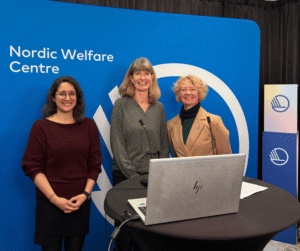Loneliness among older adults – research and implications for practice in the Nordic region
Older adults
21 Oct 2025
It is a priority for the Nordic Council of Ministers that no one should struggle with involuntary loneliness. A webinar organised together with Dalarna University and Karolinska Institutet, presented new research from the Nordic region as well as examples from practice on how to reduce loneliness among older adults.
Understanding loneliness and its outcomes
Loneliness is increasingly recognised as a public health issue that affects both physical and mental health. The webinar, Loneliness among older adults – research and implications for practice in the Nordic region, explored how loneliness affects mental health, how older adults describe their experiences with loneliness, and how interventions can be designed to address different types of loneliness.
In her presentation, professor Lena Dahlberg from Dalarna University described that the feeling of loneliness arises when there is a gap between the social relationships people desire and those they have. It may involve not having close relationships, having a reduced sense of belonging or feeling disconnected from other people. Dahlberg presented three different forms of loneliness: emotional loneliness refers to the absence of close, intimate attachment; social loneliness occurs when a person lacks a sense of belonging to a group; and existential loneliness is the feeling of being separated from others and from the world.
Loneliness is not only emotionally distressing for the individual person but also a public health concern with proven links to declining mental health. Studies presented by Stefan Fors from Karolinska Institutet show a strong association between loneliness and depressive symptoms, observed in both cross-sectional and longitudinal studies. Even though it is not possible to interpret the relationship as causal, studies show that individuals who feel lonely are more likely to develop depression, and the relationship often works both ways.
A life-course perspective was highlighted by Elisa Tiilikainen from the University of Eastern Finland. For some, loneliness emerges in older age, while for others it is a long-term condition shaped by earlier life experiences. To understand these patterns better, Tiilikainen underlined the need for longitudinal studies that follow individuals over time. Such research can give us insights into how life transitions, health, and social relations interact and inform more effective ways to reduce loneliness among older adults.
Designing interventions for different types of loneliness
When developing measures to reduce loneliness, it is important to recognise that not all loneliness is the same. Jerry Norlin, social worker and doctoral student at Dalarna University, emphasised that interventions should be adapted to the specific type of loneliness they address, whether it is social, emotional or existential.
Tailoring interventions to the nature of loneliness can therefore increase their impact and provide useful guidance for both policy and practice. This approach highlights the need for precise, evidence-based solutions rather than “one-size-fits-all” models.
Including a meso and macro level perspective
Marja Aartsen, Professor at Oslo Metropolitan University, discussed the so-called loneliness paradox in Europe. It might be expected that societies with strong individualistic values, such as the Northern European countries, would have higher levels of loneliness than societies that traditionally has a stronger emphasis on collectivistic values and social interaction such as in Southern European countries. Yet research shows that levels of loneliness are often lower in the Nordic welfare societies than in the South of Europe.
Aartsen noted that research and policy have often focused on individual explanations, such as the expectations of familiy and friends for social interaction, but we need to take account how community and societal structures also shape how loneliness develops. A broader perspective is therefore needed, one that includes both meso and macro levels such as the role of local communities, neighbourhood design, political trust and welfare provisions.
Local communities and civil society
Perspectives from practice showed how local community initiatives and civil society play a key role in preventing and reducing loneliness among older adults. Their initiatives provide opportunities for participation and social connection, complementing public services and supporting inclusion in everyday life.
The perspective of local environment was developed further by Anne Berit Rafoss from the Centre for an age-friendly Norway. Rafoss emphasised that creating age-friendly meeting places, both indoors and outdoors, can support social interaction and strengthen a sense of belonging in the community. Co-creation, universal design and local knowledge are key principles in this work, ensuring that solutions are inclusive and relevant to those who use them.
These themes will be explored further at the upcoming conference Ageing is Living: Building Age-Friendly Communities in the Nordic-Baltic Region in Copenhagen this November.
Marie Louise Söderberg from The Swedish Association of Senior Citizens, SPF Seniorerna, highlighted that older adults are a diverse group with different needs and experiences of loneliness. She stressed the importance of recognising these differences and understanding loneliness from a life-course perspective aslso presented by Elisa Tiilikainen. People who have lived with loneliness throughout life may experience it differently from those facing it for the first time in old age. Training for staff in eldercare is a way to work towards making sure that the varying needs of older adults are met while civil society initiatives can support social connection and togetherness.
These perspectives were also highlighted by Emma Lindgren from Kristianstad municipality. Lindgren noted that loneliness is influenced by factors at both individual and societal levels, and that municipalities can make a difference by promoting meeting places, volunteering and community-based activities that foster participation and inclusion.
Collaborating across sectors to reduce loneliness
The discussions of the webinar underlined that effective action against loneliness requires collaboration across research, and practice. Shared Nordic knowledge and local engagement are key to creating age-friendly environments where everyone can feel included and connected.

Related news
Older adults
10 Dec 2025
Nordic and Baltic countries sharing best practices on building an age-friendly, inclusive future
Older adults
10 Dec 2025
